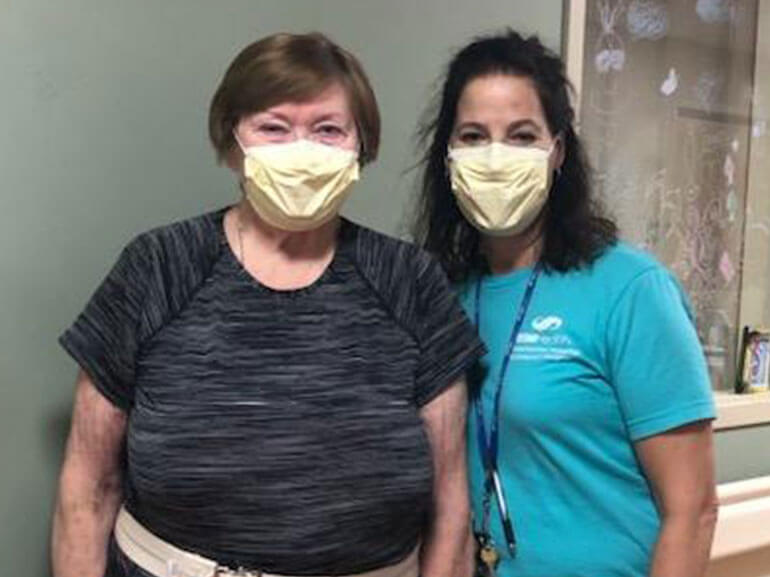Beatrice's story

Beatrice “Bea” Brady, 78, of Atchison, Kansas, is a kind and thoughtful mother, grandmother and friend. Bea keeps herself busy and productive, working full-time remotely for Fort Leavenworth Hospital and walking one-to-two miles every day. She is an active member of St. Benedict’s Catholic Church, managing accounts for the church council. She also spends her time fulfilling her duties as a Eucharistic minister, volunteering to give communion to patients in the hospital.
One day, Bea drove herself to the Kansas City airport and took a flight to St. Louis to visit her family and attend Grandparents’ Day festivities at her grandson’s school. The day after she arrived in St. Louis, Bea woke up with significant nausea, extreme weakness and a severe headache and neck pain. Bea’s daughter, Anne, rushed her to the emergency room at St. Mary’s Medical Center, where she underwent multiple MRIs, CT scans and x-rays of her chest, head and neck. Bea was diagnosed with meningitis, an infection and inflammation of the fluid and membranes surrounding the brain and spinal cord. As a side effect of the meningitis, Bea was also experiencing encephalitis, or swelling of the brain, and encephalomyelitis, which is inflammation of the brain and spinal cord. She was admitted to the hospital and immediately started on an intensive course of 24-hour IV antibiotics with only a few hours break in the middle of the day.
After a nine-day stay in the hospital, Bea was extremely weak and still had one more week of IV antibiotics to complete. However, her physicians felt she was stable enough to begin the next step in her recovery at SSM Health Rehabilitation Hospital – Richmond Heights. Bea’s battle with meningitis had left her unable to feed herself more than a few bites of food before she became too tired to continue. She also needed assistance to complete her daily personal care activities, including showering, grooming and dressing, requiring frequent rest breaks.
Upon arrival, Bea was evaluated by her physician-led team of nurses and physical, occupational and speech therapists to determine how best to help her recover. Bea was motivated and ready to get stronger so that she could get back to her busy life, with her goal being “to get stronger in every way.”
Bea’s previously active lifestyle proved to be a major asset in her recovery. In occupational therapy, Bea worked on becoming more independent and safe in conducting her personal care. While therapists worked with her on regaining her arm and hand strength, they introduced adaptive tools to help Bea feed herself without getting too tired. Therapists worked with Bea on rebuilding her core strength to improve her balance and ability to get in and out of bed. After about a week and a half, Bea was able to feed herself with normal utensils and get dressed without any physical assistance.
In physical therapy, Bea worked on improving her leg strength, balance and mobility to help with her return to walking. At first, she required maximum assistance to get in and out of bed as well as move once she was in bed. Bea was also unable to walk or stand and required the use of a lift device to help her get from the bed to her wheelchair. She worked hard and pushed herself daily to get stronger, work on her balance and build her endurance. Bea started stretching her calf muscles daily so she could regain her flexibility to help her pick up her toes when walking. She began by walking in the parallel bars, then progressed to walking with a walker with a wheelchair following behind her for safety. Soon, Bea was walking with the walker with her physical therapist only assisting her while turning and navigating obstacles.
Bea formed an immediate connection with her speech therapist, whose son attended college in the same small town in which Bea lived. Cognitive testing revealed a mild impairment in Bea’s memory skills, which was addressed by working on a variety of stories to remember details as well as logic puzzles and organizational tasks. Bea made quick progress and was able to “graduate” from speech therapy during her rehab stay in order to spend more time addressing her physical and occupational therapy goals.
During her time at SSM Health Rehabilitation Hospital, Bea’s family was a great support. Anne, who lives in St. Louis, visited multiple times a day, while her son and daughter who live in Washington, DC and New Jersey, respectively, both visited twice. “I have the most wonderful family who has been a huge help throughout this entire experience,” Bea stated. Anne also participated in family training which brought her up to speed on Bea’s progress to prepare for Bea’s discharge. After 21 days of rehabilitative care, Bea was able to complete all her daily activities without assistance or supervision and could walk 160 feet with her walker and go up and down 12 steps.
At discharge, Bea planned to stay with Anne as she continues to rebuild her strength with additional therapy at SSM Day Institute in Kirkwood with the end goal of returning to her beloved house and community in Kansas.
When asked what she learned over the course of her recovery, Bea said, “I’ve been forced to learn some patience, which I don’t have a lot of. It was tough to feel 100 percent one day and then the next day not be able to lift a finger because I was so weak and sick.” She continued, “The therapists kept telling me that I was making progress and that was so encouraging, because I didn’t think I was – I thought I was going to be here for a year! Thanks to my wonderful therapists who challenged me each day and my supportive family and friends back home, I have made a fairly quick recovery.”